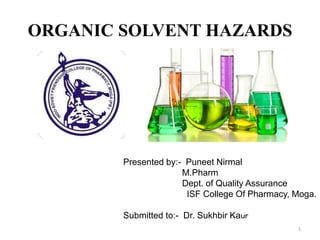
Organic solvent hazards
- 1. ORGANIC SOLVENT HAZARDS Presented by:- Puneet Nirmal M.Pharm Dept. of Quality Assurance ISF College Of Pharmacy, Moga. Submitted to:- Dr. Sukhbir Kaur 1
- 2. Introduction The impact of mankind on the environment is profound and in many cases has been both negative and irreversible. A combination of heavy growth in population and rapid industrialization has created an environmental crisis all over the world. In this era, environmental damage from various sources has become a sacrifice, which seems to be acceptable in the interest of development. However, the effects of wide spread industrial development on the environment has become a major concern in the present century. 2
- 3. A vast majority of the organic solvents used in industry and laboratories are volatile hazardous and toxic organic compounds. Many of these solvents are volatile organic liquids that evaporate easily at normal temperature and pressure, thereby readily producing volatile organic compound emissions. 3
- 4. Organic solvent, Where it is use? In chemical laboratories, organic solvents are used as: • Liquid medium in syntheses, extractions, separations, purification and drying • Play an important role in analytical methodologies, spectrometric measurements and physicochemical properties measurements. • Widely used for dissolving and dispersing fats, oils, waxes, pigments, varnishes, rubber etc. • They are also used as thinners and solvents in paints, varnishes, inks, waxes, floor and shoe polishes, glues, fuels, antifreeze, degreasing, cleaning and dry cleaning agents. 4
- 5. Toxic effects of Hazardous solvents: • Spills and leakages of solvents cause significant air, land and water pollution • Fuel spills that infiltrate the ground can cause significant contamination of drinking water sources, like: one litre of kerosene can contaminate 100 million litres of drinking water due to their toxic nature, irritant and carcinogenic properties also cause to many health issues such as headache, nausea, dizziness and weakness, etc. • Are highly flammable and require special handling and storage to avoid combustion. 5
- 6. Health effects: Skin: The skin contains high levels of fats and upon contact with solvents can cause defatting. As a result, the skin becomes dry, scaly and eventually cracked. A dry, cracked skin tissue further allows greater absorption of solvent upon direct contact. Solvents like Toluene, Xylene, Butanol & Styrene cause skin irritation and irritant dermatitis. Respiratory tract: All organic solvents irritate the upper respiratory tract to some degree. Long-term exposure to the stronger irritants(Ex. Aldehydes) may lead to chronic or persisting cough and increased sputum production 6
- 7. Cont… Liver: Liver acts as a central organ for detoxification of harmful substances and is particularly prone to damage. Detoxification by liver enzymes usually involves converting a substance into a more hydrophilic metabolite to accelerate its excretion. Heart: Chlorinated organic solvents, such as Methylene chloride and Trichloro ethane are known for their harmful effects on the heart. Repeated exposure to some solvents can cause cardiac sensitization, which can produce life-threatening irregularities in the rhythm of the heart, which can be considered as a possible cause of sudden death 7
- 8. Characteristics of organic solvents determine the type of hazards they present: A majority of organic solvents are volatile. The greater the volatility of a solvent the greater the vapor concentration in the air. Hence, inhalational exposure is an important exposure pathway to be considered when assessing the health hazards of the solvents. A very majority of organic solvents show the tendency to evaporate at ambient temperatures and are easily absorbed through the skin. The two most important exposure pathways for organic solvents in the workplace are through lungs and skin. 8
- 9. Cont.. • Many organic solvents have low flash points and will burn if ignited. The flammability and explosiveness of a solvent are clearly important determinants of hazard associated with its use. Some solvents may also be explosive Ex. Nitrocellulose. There may also be a risk of exothermic reactions of some solvents with other materials, which may lead to fire or explosion. The following classification is used to qualify the flammability hazard associated with a solvent: • HIGHLY FLAMMABLE: flashpoint <23°C • FLAMMABLE: flashpoint23-61°C • COMBUSTIBLE: flashpoint 61-150°C Solvents such as DiMethylsulfoxide and glycol ethers, which have both water and lipid solubility are well absorbed through the skin. 9
- 10. Precautions: • Wear Protective gloves resistant to the specific chemical ( For concentrated organic solvent Use Natural rubber, neoprene, or nitrile gloves) • Wear facemask • Wash hands thoroughly with an appropriate soap after handling solvents. • Proper disposal of used solvents to avoid the chances of hazardous event. • Store solvents in strong, sealed containers. • Clearly identify and labels the containers. • Establish procedures and evacuation routes in case of a fire or a solvent spill. • Wear protective clothing • Read the Safety Data Sheets (SDS) provided by manufacturers and suppliers and should be available at workplaces where solvents are used. 10
- 11. 11
- 12. The various label used in laboratory: 12
- 13. Reference • http://www.journaljpri.com/index.php/JPRI/ar ticle/view/30203 • https://www.researchgate.net/publication/33 4118785_An_Overview_on_Common_Organic _Solvents_and_Their_Toxicity • https://www.jchps.com/specialissues/Special %20issue3/17%20jchps%20si3%20k.pruthu%2 083-86.pdf 13
- 14. 14
